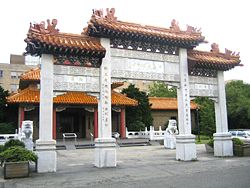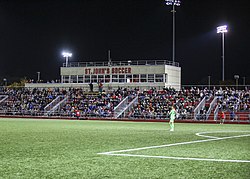 | |
Former name | St. John's College (1870–1933) St. John's University, Brooklyn (1933–1954) [1] |
|---|---|
| Motto | Educatio Christiana Animae Perfectio |
Motto in English | Christian education perfects the soul |
| Type | Private university |
| Established | 1870 |
| Founder | John Loughlin |
Religious affiliation | Catholic (Vincentian) |
Academic affiliations | ACCU NAICU |
| Endowment | $819 million (2024) [2] |
| President | Brian Shanley |
| Provost | Simon Geir Møller |
Academic staff | 1,400 (As of fall 2020) |
| Students | 20,150 (As of fall 2020) |
| Undergraduates | 15,700 (As of fall 2020) |
| Postgraduates | 4,450 (As of fall 2020) |
| Location | , New York , United States 40°43′19″N73°47′44″W / 40.72194°N 73.79556°W |
| Campus | List
|
| Colors | Red White Navy Blue [3] |
| Nickname | Red Storm |
Sporting affiliations | NCAA Division I Big East Conference |
| Website | www |
 | |
 | |
St. John's University is a private Catholic university in Queens, New York City, United States. It was founded in 1870 by the Congregation of the Mission (C.M., the Vincentian Fathers) with a mission to provide the youth of New York with a Catholic university education. [4] Originally located in the Brooklyn borough of New York City, the flagship campus was moved to its current location in the Queens borough during the 1950s. [5] St. John's has an additional New York City campus in Manhattan. The university's Staten Island campus closed in May of 2024. [6] [7] Additionally, the university has international campuses located in Rome, Italy; Paris, France; [8] and Limerick, Ireland. [9]
Contents
- History
- Foundations
- Founding principles
- Growth
- Further expansion (1999–present)
- Other notable events
- Organization and administration
- Academics
- Colleges
- Student body
- Faculty
- Rankings and reputation
- Student life
- Fraternities and sororities
- Media
- Performing arts
- Art exhibitions
- Campuses
- Branch campuses
- Former branch campuses
- Campus renovations
- Athletics
- Conference affiliation
- Men's baseball
- Men's basketball
- Fencing
- Men's soccer
- Women's athletics
- Controversies
- Rivalries
- Notable alumni
- Notes
- References
- Further reading
- External links
St. John's is organized into five undergraduate schools and six graduate schools offering more than 100 bachelor, master, and doctoral degree programs as well as professional certificates. In 2019, the university had 17,088 undergraduate and 4,633 graduate students. The student body represents 46 states, District of Columbia, Guam, Puerto Rico, U.S. Virgin Islands, and 119 countries. As of 2020, St. John's alumni total more than 190,000 worldwide. [1]




















